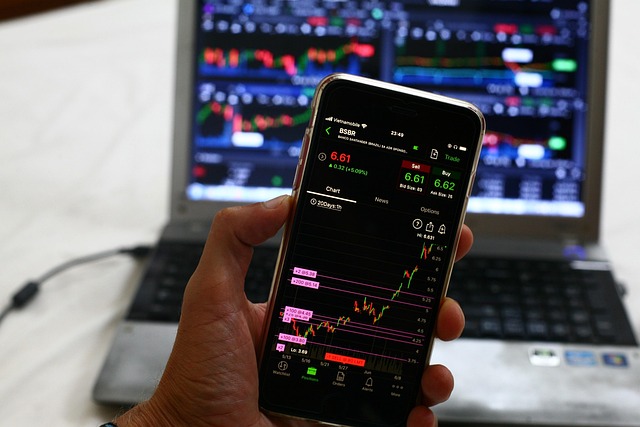Bitget Trading App: Features, Tips, and Strategies
Author: Jameson Richman Expert
Published On: 2025-10-23
Prepared by Jameson Richman and our team of experts with over a decade of experience in cryptocurrency and digital asset analysis. Learn more about us.
The Bitget trading app is a powerful mobile and desktop platform that combines spot, margin, and derivatives trading with social copy-trading, advanced charting, and portfolio management. This article explains how the Bitget trading app works, its core features, security and fees, practical trading strategies, and how to integrate trading signals and incentives to improve your results. Whether you’re a beginner or an experienced trader, you’ll find actionable steps, real-world examples, and resources to evaluate Bitget alongside other major exchanges.

What is the Bitget Trading App?
The Bitget trading app is the client-facing application for Bitget, a cryptocurrency exchange focused on derivatives and copy-trading services. It provides a unified environment for spot markets, futures (perpetual) contracts, leveraged trading, and portfolio tracking. Bitget’s mobile apps (iOS and Android) and web platform are designed to make advanced trading accessible while offering social features that allow users to follow and copy professional traders.
For background on how crypto signals and automated tips fit into a trader’s workflow, see this in-depth analysis of whether crypto signals work: Does Crypto Signals Work — An In-depth Analysis.
Key Features of the Bitget Trading App
- Multi-market Access: Spot trading, margin, and perpetual futures all in one app.
- Copy Trading: Follow and automatically mirror professional traders’ orders through Bitget CopyTrade.
- Advanced Order Types: Market, limit, stop-limit, OCO (One Cancels the Other), and conditional orders.
- Charting & Indicators: Integrated TradingView charts with numerous technical indicators and drawing tools.
- Risk Controls: Leverage management, position isolation, and margin modes for derivatives.
- Security: 2FA, withdrawal allowlisting, cold storage for assets, and enterprise-grade custody practices.
- Educational & Social Tools: Market news, strategy guides, and social feeds showing top traders and performance metrics.
Why traders choose Bitget
Traders often select Bitget for its copy-trading ecosystem and derivatives liquidity. The platform is particularly attractive to traders who want to combine algorithmic or professional trader strategies with a user-friendly mobile interface. Bitget also runs frequent promotions, competitions, and incentives that can lower trading costs or provide bonuses for new accounts.
For a look at incentives and why opening a brokerage or trading account in 2025 might be advantageous, consider: Incentives for Opening a Brokerage Account in 2025.
Getting Started: Account Setup and Verification
- Register an Account: Download the Bitget app or use the web platform and register. (If you want to compare sign-up flows across exchanges, you can register with Binance, MEXC, Bitget, or Bybit via these links: Register with Binance, Register with MEXC, Register with Bitget (referral), Register with Bybit.)
- Complete KYC: Verify identity to lift withdrawal limits and access derivatives in jurisdictions where required.
- Enable Security: Set up strong passwords, enable two-factor authentication (2FA), and add withdrawal address whitelists.
- Fund Your Wallet: Deposit crypto or fiat (where supported) and transfer between wallets: spot, margin, and derivatives as needed.
Practical tip
Start small: Fund the account with a small amount first to practice order types, test copy traders on small allocations, and become familiar with the app workflows before scaling up.

Trading Tools and Order Types Explained
Understanding order types and tools is essential. Bitget provides a full suite suitable for active traders:
- Market Orders: Immediate execution at the best available price. Use when speed matters.
- Limit Orders: Set a specific price. Use for precise entry or exit points to avoid slippage.
- Stop-Loss & Take-Profit: Conditional orders to manage downside and lock gains.
- OCO Orders: Place a stop and limit simultaneously — one triggers and cancels the other.
- Leverage & Margin Modes: Isolated vs cross margin and adjustable leverage for futures contracts.
- Trailing Stop: Dynamic stop that follows price to protect upside while limiting downside.
For technical background on order types and best practices, consult an authoritative resource like Investopedia’s explanation of limit orders: Limit Order — Investopedia, and the general concept of cryptocurrency exchanges on Wikipedia — Cryptocurrency Exchange.
Copy Trading on the Bitget Trading App
Bitget’s CopyTrade feature allows followers to replicate the trades of professional traders automatically. It’s useful for beginners who want exposure to experienced strategies without coding.
How to use CopyTrade
- Open the CopyTrade section in the Bitget app.
- Browse popular traders and analyze their historical performance, max drawdown, win rate, and risk parameters.
- Allocate a portion of your capital to copy that trader; set your own stop-loss and maximum allocation limits.
- Monitor and periodically rebalance. You can stop following at any time and manually close positions.
Risk note: Past performance is not proof of future returns. Always apply position sizing and diversification rules when copying.
Security Best Practices
Security is critical when using any trading app. Follow these best practices on the Bitget trading app:
- Enable 2FA and use an authenticator app (Google Authenticator or Authy) rather than SMS where possible.
- Whitelist withdrawal addresses to prevent unauthorized transfers.
- Use hardware wallets for long-term or large holdings and only keep trading capital on exchanges.
- Monitor account activity and set email/SMS alerts for logins and withdrawals.
- Be cautious with API keys—only enable necessary permissions and keep strict IP restrictions for automated trading.
Learn more about safe crypto custody from authoritative sources such as the U.S. Securities and Exchange Commission’s retail investor alerts: SEC Investor Alerts.

Fees, Funding, and Promotions
Trading costs can erode returns, so understand Bitget’s fee structure and funding routes.
Typical fee components
- Spot Trading Fees: Maker and taker fees based on tiered volume or token holdings.
- Futures Fees: Funding rates and trading fees; funding rates can be positive or negative depending on market pressure.
- Deposit/Withdrawal Fees: Crypto network fees apply; fiat gateways may charge additional fees.
- Conversion Fees: When moving between wallets or converting tokens.
Bitget frequently runs promotions that reduce fees or provide trading bonuses. If you’re specifically opening an account because of incentives, this article on incentives is useful: Incentives for Opening a Brokerage Account in 2025.
Example fee calculation
Suppose you execute a $10,000 futures trade with a 0.02% maker fee. Fee = $10,000 * 0.0002 = $2. If you leverage 10x, notional exposure is $100,000 but fees are calculated on executed notional; always verify how the platform calculates fees on leveraged positions.
Practical Trading Strategies for the Bitget Trading App
Below are practical, actionable strategies that work well in the Bitget environment. Each includes a concise example and risk-control rules.
1. Trend-following with Stop-Loss
Use higher-timeframe moving averages to define trend, then enter pullback trades on shorter timeframes.
- Setup: 50-period and 200-period EMA on 4-hour chart. Buy when 50 EMA > 200 EMA and price pulls back to 50 EMA.
- Stop-loss: Below the recent swing low.
- Take-profit: Risk-to-reward 1:2 minimum; trail stop as trend continues.
2. Mean Reversion on Low Volatility Pairs
Apply Bollinger Bands or RSI to trade reversion in stable altcoin pairs.
- Setup: 20 SMA with Bollinger Bands; buy when price touches lower band and RSI < 30.
- Risk: Small position size and tight stop-loss to mitigate trend breakouts.
3. Leveraged Breakout Strategy (Futures)
Use consolidated range breakouts on high-liquidity contracts (e.g., BTC/USDT perpetual).
- Entry: Break above 24-hour consolidation high on increased volume.
- Leverage: Conservative leverage (2x–5x) and initial stop below the breakout level.
- Risk management: Use fixed fractional position sizing, e.g., risk 1% of capital per trade.
Example trade
Imagine BTC/USDT trades in a $1,000 range between $64,000 and $65,000. Price breaks above $65,000 on volume. You enter at $65,100 with a 3% account risk. If account is $10,000, you risk $300. With a $500 stop-loss distance, position size = $300 / $500 = 0.6 contracts equivalent. Use Bitget’s order types to place stop and take-profit simultaneously.
Using Trading Signals and Automation
Integrating trading signals into the Bitget trading app can speed decisions but requires validation. Automated signals can be obtained from proprietary systems, social traders, or third-party services. Always backtest and apply position sizing.
For a critical review of signal reliability and best practices, read this examination of crypto signals: Does Crypto Signals Work — An In-depth Analysis.
How to use signals safely
- Confirm signals with your own analysis (trend, liquidity, and risk metrics).
- Use partial allocations and scale-in methods rather than full allocation on a single signal.
- Combine signals with automated risk controls (stop-losses and position-size limits).

Tax and Reporting Considerations
Cryptocurrency trading has tax implications in most jurisdictions. Keep accurate records of trades, deposits, withdrawals, and conversions. Use portfolio-tracking tools that export tax-ready reports. Consult your local tax authority for precise rules—e.g., U.S. taxpayers can review IRS guidance: IRS — Virtual Currency Guidance.
Comparing Bitget to Other Trading Apps
When evaluating the Bitget trading app, compare core factors with competitors: liquidity, fees, order types, regulatory status, security, and additional features like staking or derivatives. If you want to try other platforms, consider these links to create accounts and directly compare user experience:
- Register with Binance — broadest liquidity and asset coverage.
- Register with MEXC — known for new token listings and promotions.
- Register with Bitget (referral) — directly access the Bitget trading app features discussed here.
- Register with Bybit — strong derivatives platform with competitive fees.
Market Outlook and Strategy Alignment (2025+)
Strategic trading should account for macro trends and expected price ranges. For a forward-looking market outlook, see crypto price prediction research that discusses factors shaping 2025 markets: Crypto Price Prediction 2025 — A Comprehensive Outlook. Use these macro views to decide allocation between spot holdings and leveraged short-term trades.

Common Mistakes to Avoid on the Bitget Trading App
- Over-leveraging: High leverage increases liquidation risk—use conservative leverage and ensure margins are adequate.
- Poor position sizing: Risking too much per trade damages long-term performance—adhere to a fixed-fraction risk rule (e.g., 1–2% per trade).
- Chasing trades: Entering emotional trades at new highs without plan increases losses.
- Ignoring fees: Frequent trades can generate significant fees; use maker orders and limit orders where suitable to reduce costs.
- No backup plan for access: Keep account recovery details and 2FA backup codes secure in case of device loss.
Advanced Tips for Power Users
- Use API for automation: If you run algorithms or bots, create API keys with least privileges and IP restrictions.
- Run paper-trades: Practice strategies on testnets or small sizes before full deployment.
- Leverage analytics: Export trade history and analyze edge metrics like average win/loss, expectancy, and Sharpe ratio.
- Diversify across strategies and assets: Combine trend, mean-reversion, and carry strategies to reduce correlation.
Is the Bitget Trading App Right for You?
Bitget fits traders who value an integrated copy-trading environment, derivatives access, and a mobile-first experience. It may be less suitable for traders in jurisdictions where regulatory scrutiny limits features or for those prioritizing extreme low-latency market-making (institutional-grade platforms may be better). Always evaluate regulatory compliance and whether the exchange supports your jurisdiction.
Checklist before committing capital
- Confirm supported assets and trading pairs you need.
- Check fees for your expected trade frequency.
- Verify KYC and withdrawal limits for your jurisdiction.
- Test the app with small trades and try copy trading with limited allocation.
- Implement security and backup measures.

Conclusion
The Bitget trading app provides a feature-rich platform that blends derivatives trading, spot trading, and social copy trading. Its integrated charts, order types, and educational tools make it accessible for beginners while offering the depth professionals expect. Use strict risk management, validate trading signals, and compare offers and incentives across platforms to optimize your trading costs. For further reading on how to assess signals and market incentives, review these resources: Does Crypto Signals Work — An In-depth Analysis, Incentives for Opening a Brokerage Account in 2025, and Crypto Price Prediction 2025 — A Comprehensive Outlook.
If you want to compare platforms or open an account to try the features discussed, here are sign-up links for quick access: Binance registration, MEXC registration, Bitget registration (referral), and Bybit registration.
Final reminder: Crypto markets are volatile. Use capital you can afford to lose, maintain disciplined risk controls, and continue learning through practice and reputable educational resources.